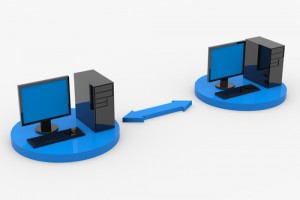 Remote desktop access programs help users work on a computer through another one. Such programs can be extremely helpful for mutual work between people, technical support, and various help and tutorials. Basically, desktop sharing programs are perfect for all sorts of situations when a person can’t physically be next to a PC but needs to access one. The most popular program of this kind was TeamViewer, which has become so famous thanks to its simplicity in use and decent list of features it offers. However, this desktop sharing program is by far not the only one that can provide the same functionality and interface to the users. We reviewed and rated the best free TeamViewer alternatives for you to consider when searching for remote desktop access software.
Remote desktop access programs help users work on a computer through another one. Such programs can be extremely helpful for mutual work between people, technical support, and various help and tutorials. Basically, desktop sharing programs are perfect for all sorts of situations when a person can’t physically be next to a PC but needs to access one. The most popular program of this kind was TeamViewer, which has become so famous thanks to its simplicity in use and decent list of features it offers. However, this desktop sharing program is by far not the only one that can provide the same functionality and interface to the users. We reviewed and rated the best free TeamViewer alternatives for you to consider when searching for remote desktop access software.
1. join.me
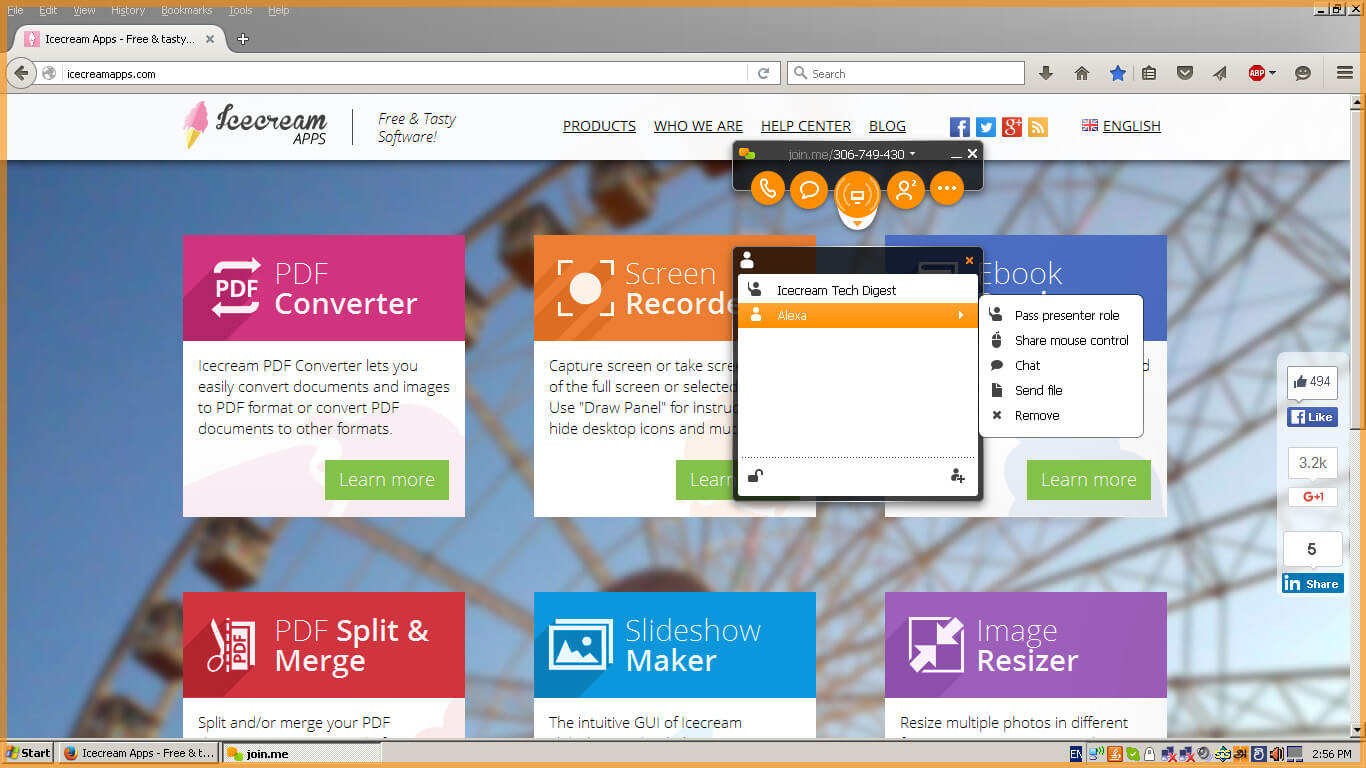 join.me is a highly convenient TeamViewer alternative thanks to the fact that it’s possible to share a screen session by the URL. Basically, the receiver of such a URL doesn’t have to install anything on a PC, it is required just to open a link in a web browser. This link can optionally be copied or sent by email. The huge plus of join.me is that even without the installation, all the participants can use the session’s chat and request mouse control over the other participant’s computers. To request annotation and a presenter’s role, the program should be downloaded and installed on a computer, however these features are perfectly supported.
join.me is a highly convenient TeamViewer alternative thanks to the fact that it’s possible to share a screen session by the URL. Basically, the receiver of such a URL doesn’t have to install anything on a PC, it is required just to open a link in a web browser. This link can optionally be copied or sent by email. The huge plus of join.me is that even without the installation, all the participants can use the session’s chat and request mouse control over the other participant’s computers. To request annotation and a presenter’s role, the program should be downloaded and installed on a computer, however these features are perfectly supported.
A presenter is also capable of putting the screen sharing session on pause and resuming it whenever they require. File transfer is supported through this handy program as well as a custom name for each participant of the session.
Pros: The participants of the session don’t have to have Join.me installed; cross-platform; lets you share mouse control; and you can switch presenters.
Cons: None
Size: 35MB
Rating by Icecream Tech Digest: 10/10
2. Mikogo
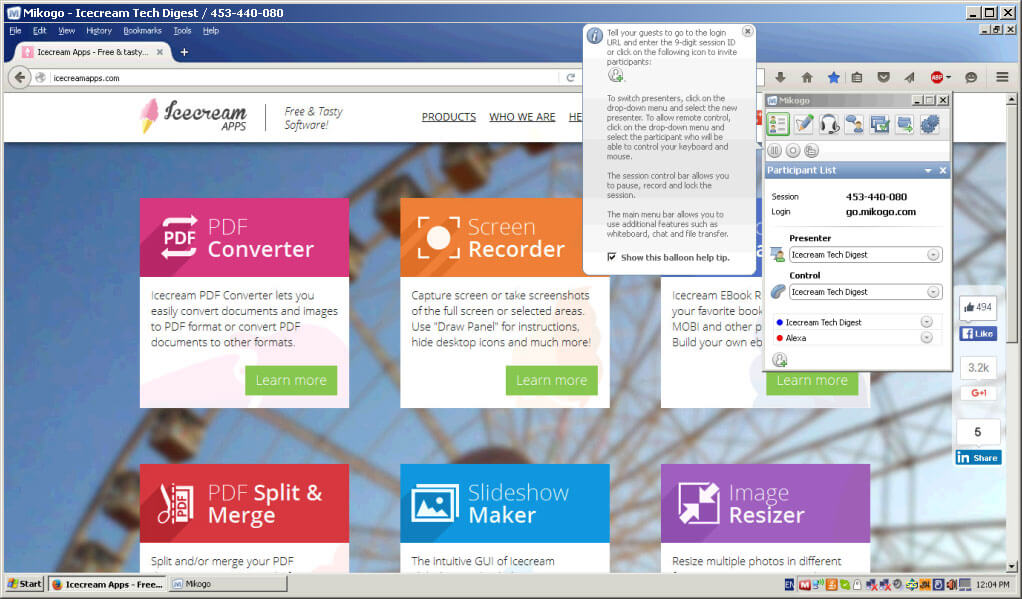 Mikogo is a great compact desktop sharing software that is highly convenient to use. One of the major features of it is that during the session it’s possible to switch the so-called presenter (a user that shares a screenshot). Another cool thing is that the person with whom you’d like to work with through Mikogo doesn’t need to install it. You can share an instruction of how to join a session by email or copy it for further pasting. According to this instruction, its receiver gets a compact (little less than 7MB) portable version of Mikogo. The same portable version can be used for logging in to screen sharing sessions by their ID. However, to be able to start a session, an account is required.
Mikogo is a great compact desktop sharing software that is highly convenient to use. One of the major features of it is that during the session it’s possible to switch the so-called presenter (a user that shares a screenshot). Another cool thing is that the person with whom you’d like to work with through Mikogo doesn’t need to install it. You can share an instruction of how to join a session by email or copy it for further pasting. According to this instruction, its receiver gets a compact (little less than 7MB) portable version of Mikogo. The same portable version can be used for logging in to screen sharing sessions by their ID. However, to be able to start a session, an account is required.
In addition to that, Mikogo supports whiteboard mode that can be used to add graphics and text to the screen. Voice conferencing, file transfer, and chat are also available for the users. In addition to that, desktop sharing sessions can be recorded and saved as video files.
Pros: Easy to use; cross-platform; offers plenty of features such as chat, whiteboard, recording of sessions, voice conferencing, and switching presenters.
Cons: The interface could be a bit more modern.
Size: 12MB
Rating by Icecream Tech Digest: 9/10
3. AnyDesk
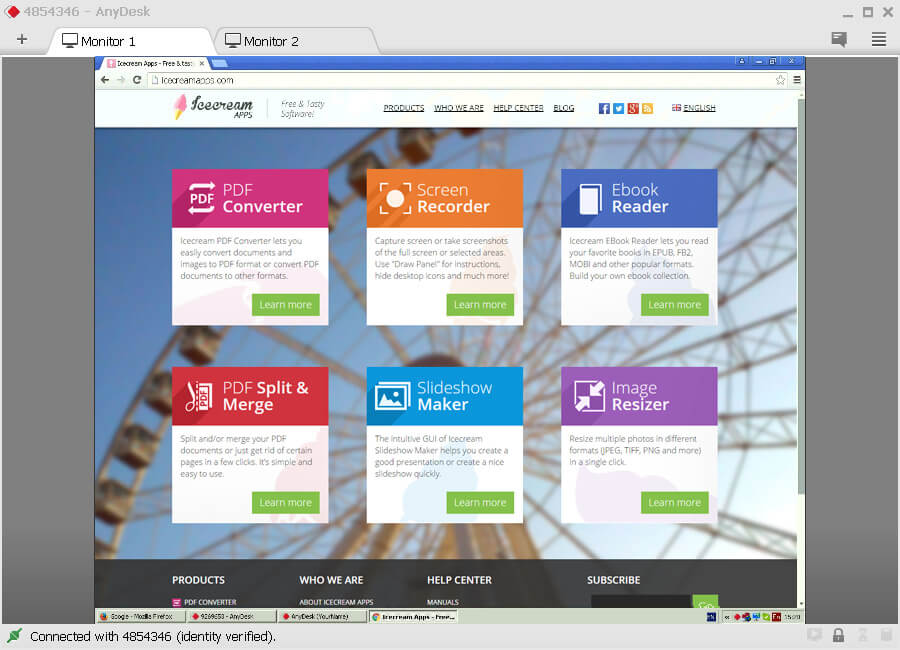 AnyDesk is an easy-to-use and super compact remote desktop software. The process of use starts with downloading a portable file that you can immediately run to share a desktop. To share a desktop, another AnyDesk user should enter your PC’s ID (AnyDesk-Address). As soon as you receive a request for connection, you can accept or reject it. If a person doesn’t have this TeamViewer alternative installed, there’s a possibility to send an invitation by email.
AnyDesk is an easy-to-use and super compact remote desktop software. The process of use starts with downloading a portable file that you can immediately run to share a desktop. To share a desktop, another AnyDesk user should enter your PC’s ID (AnyDesk-Address). As soon as you receive a request for connection, you can accept or reject it. If a person doesn’t have this TeamViewer alternative installed, there’s a possibility to send an invitation by email.
As soon as the session is started, users can share mouse and keyboard control, take screenshot of the controlled desktop, and synchronize clipboard. A chat feature is supported by AnyDesk as well as file exchanging. It’s possible to protect the machine from unattended access with a password. What we found quite convenient was that this remote desktop sharing software recognizes the monitors of a PC while connected, and each monitor is opened in a new tab inside of the program’s window.
Pros: Compact in size; portable; a clean and easy-to-use interface; multiple monitors recognition; and high speed of work.
Cons: No whiteboard
Size: 2MB
Rating by Icecream Tech Digest: 9/10
4. Chrome Remote Desktop
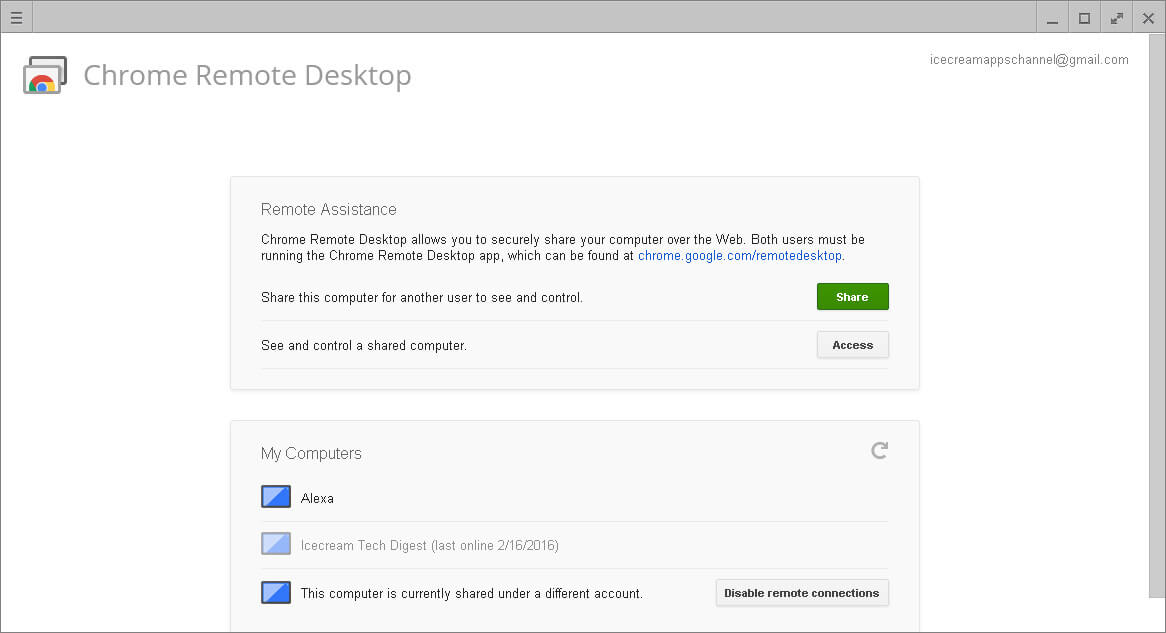 Chrome Remote Desktop is a Google Chrome browser extension for simple remote desktop access. First you need to add the app to the browser, then the installer should be downloaded and set up, and then you need to log into your Google account. This TeamViewer alternative works in two modes: it’s possible to connect all the devices within a single Google account to connect to them by means of a six-digit PIN; or it’s possible to share your machine and control others by means of the Remote Assistance feature regardless of unity of a Google account. To share your computer, click the “Share” button to receive a 12-digit number. To access a machine remotely, click the “Access” button and insert such a number, no PIN is needed.
Chrome Remote Desktop is a Google Chrome browser extension for simple remote desktop access. First you need to add the app to the browser, then the installer should be downloaded and set up, and then you need to log into your Google account. This TeamViewer alternative works in two modes: it’s possible to connect all the devices within a single Google account to connect to them by means of a six-digit PIN; or it’s possible to share your machine and control others by means of the Remote Assistance feature regardless of unity of a Google account. To share your computer, click the “Share” button to receive a 12-digit number. To access a machine remotely, click the “Access” button and insert such a number, no PIN is needed.
Unfortunately, Chrome Remote Desktop offers remote desktop access and, basically, that’s it. Unlike other TeamViewer alternatives reviewed, this desktop sharing tool doesn’t offer chat, file sharing, whiteboards, annotations, etc. You can only access and control the desktop of another PC.
Pros: Easy to use; and multiple monitors recognition.
Cons: Only works with Google Chrome and Google Account; allows for simple sharing; and no extended features (chat, whiteboard, file sharing, etc.).
Size: 6.6MB
Rating by Icecream Tech Digest: 7/10
5. Splashtop

Splashtop is a cross-platform desktop sharing software that is primarily useful for those who access desktops of specific computers on a regular basis. Splashtop requires two different types of the program to be installed on a computer: a program for the computers that you want to remote from, and a program for the computers to remote to (a so-called Streamer). The connection happens in the following way: you create an account through an email and on each PC or mobile device install one of two available types of the program. As soon as it’s done, refresh the list of the machines on the PC with the software to remote from installed to see all the connected computers you can access.
The desktop sharing session starts immediately after the machine from the list is selected and the “Connected” button next to it is connected. As for the options, before the session, it’s possible to select the resolution of the connection. During the session, switching monitors for PCs with multiple ones is available.
Pros: Cross-platform; and easy to use.
Cons: To access a desktop and to share it there are two different versions of the program required; all the machines of the network should be assigned to a single account and email; and not many features while desktop sharing.
Size: 13MB (Personal app to remote from)/34MB (Streamer app to remote to)
Rating by Icecream Tech Digest: 6/10
TeamViewer is a great and easy-to-use desktop sharing software. However, recently, some nice TeamViewer alternatives have become available on the market, as showed in this article. Select the best remote desktop tool that suits your needs the most.
ammyy ?? supremo ???
Mic Mic, thank you for these suggestions, we’ll take this information into account.
You should mention that many use TeamViewer for unattended access, which is NOT supported by join.me, Mikogo, Chrome Desktop, but is by SplashTop and Anydesk, hence the reason for the install. Also, Splashtop has an android and ios app. Not quite sure about the others.
You may also add R-HUB remote support servers to the above list of remote desktop software.
Thank you for this suggestion, we appreciate it!
can you tell me which app shares files from own desk to remote m/c
i have a problem with teamviewer iits shows commercial use and closed within 1 or 2 min
Olá,
Aqui está uma excelente lista de programas analógicos, mas não notei que uma opção é o Litemanager Free. Porque é uma alternativa equivalente que não cederá aos programas acima mencionados.
Hello Jim,
Thank you for the suggestion, we will take this into account!
I’ve mentioned this in other articles but it’s about time you added NoMachine to the options. Free for personal use, IMHO it beats all of the options you mention for quality.
none of these got floating tabs (one per monitor) like TeamViewer does.
I’ve been using Deskgate for a while. Excellent performance and complies with the law on the protection of personal data.
military cryptography is a very reliable remote connection program.